Developing Low-Carbon Pathways for the Transport Sector in Ethiopia
Abstract
1. Introduction
2. Literature Review
3. Ethiopian Context
3.1. Overview of Ethiopia’s Transport Sector
3.2. Transport Sector Energy Analysis
3.3. Transport-Sector GHG Contribution and Inventory
3.4. Transport Sector Policy
- Climate Resilient Green Economy Strategy (CRGE, 2010)
- The CRGE is one of the first policy documents developed by the government of Ethiopia with the aim of establishing a climate-resilient economy by 2025. The policy focuses on sustainable development while addressing climate change. The transport-sector strategies under the CRGE emphasise implementing low-carbon transportation systems, promoting electric vehicles (EVs), and enhancing public transport. The CRGE provides a foundational framework for integrating climate considerations into transport planning.
- Growth and Transformation Plans (GTP I, 2013) and (GTP II, 2016)
- GTP I and GTP II set ambitious infrastructure development goals, including significant road, rail, and air transport investments. GTP I enhances the road network and expands rail infrastructure, particularly the Addis Ababa–Djibouti railway. GTP II continues along this trajectory, emphasising the importance of sustainable transport systems that support economic growth while reducing environmental impact.
- Transport Sector GHG Inventory Report (2018)
- This report highlights the transport sector’s contribution to national GHG emissions, providing a baseline for future mitigation efforts. It identifies key areas for improvement, such as transitioning to cleaner fuels, increasing public transport usage, and promoting non-motorised transport (NMT). The findings have informed subsequent policy revisions and the development of more targeted interventions.
- National Transport Policy (2020)
- This policy was adopted to guide the development and management of the transport sector. It emphasises integrating transport planning, investing in infrastructure, and promoting sustainable practices. It aligns with the goals of the GTPs and CRGE, reinforcing the need for a comprehensive approach to transport development that considers economic, social, and environmental factors.
- Non-Motorised Transport Strategy (2020)
- The NMT strategy aims to promote walking and cycling as viable transportation options. It addresses the need for safe and accessible infrastructure for pedestrians and cyclists, contributing to reduced traffic congestion and lower emissions. This strategy complements the broader efforts to enhance public transport and improve urban mobility.
- Updated Nationally Determined Contributions (2021)
- Ethiopia’s updated NDCs outline its commitments to reducing GHG emissions by 50% by 2030, with significant contributions expected from the transport sector. This includes promoting EV adoption, enhancing public transport, and improving the fuel efficiency of vehicles. The updated NDCs align with international climate goals and demonstrates Ethiopia’s commitment to sustainable development.
- Ten-Year Development Plan (2021–2030)
- The Ten-Year Development Plan outlines strategic initiatives for economic growth, with a strong focus on infrastructure development. It emphasises the need for a resilient transport system that supports trade and connectivity while addressing environmental sustainability. The plan seeks to attract investment in transport infrastructure, including roads, railways, and airports.
- Ethiopian Transport Master Plan (2022)
- This comprehensive master plan provides a roadmap for the development of the transport sector over the next three decades. It emphasises integrated transport systems, regional connectivity, and the need for sustainable financing mechanisms. The plan aligns with national and international objectives, promoting a holistic approach to transport development.
- EV Standards (2022)
- The introduction of EV standards marks a significant step towards promoting electric mobility in Ethiopia. These standards aim to facilitate the adoption of EVs, improve charging infrastructure, as well as ensure safety and performance. This initiative supports the broader goals of reducing emissions and transitioning to a sustainable transport system.
4. Materials and Methods
4.1. Data Collection and Processing
4.2. Stakeholder Interactions
- Initial workshop and project kick-off
- This workshop presented the project objective, work plan, and modelling approach to stakeholders. The workshop also had scoping and visioning exercises to portray the development pathways and targets for the LEDS. A working group led by the MoTL, consisting of key experts from the earlier-mentioned stakeholders, was also formed for the transport LT-LEDS.
- Draft baseline scenario validation
- After the working group collaborated to develop their sectoral working plan and draft the baseline scenario, this workshop aimed to present the baseline scenario results and assumptions to experts as well as to gather feedback and inputs to further improve and validate the baseline scenario, including the assumptions and methodologies.
- Youth and women stakeholders’ session:
- This workshop was used to familiarise civil society organisation (CSO) networks dealing specifically with women and youth with the LED strategy development process and to discuss ways to engage them in climate-change-related issues.
- Baseline finalisation and low-carbon scenario modelling workshop
- The objectives of this workshop were to finalise the baseline scenario, discuss sectoral priorities for mitigation scenarios, and enhance the modelling capacity of government experts in the MoTL. The workshop was efficient as a first round of prioritising mitigation and adaptation actions in the sectors. An integrated assessment of the mitigation and adaptation actions, identifying synergies and trade-offs, was also conducted in preparation for modelling the mitigation options.
- National stakeholder consultation and modelling training
- The aim was to further consult on the LT-LEDS and to validate the low-carbon-emission scenarios. In addition, the workshop had follow-up modelling training sessions that helped the participants to understand the tools and methods used in developing the BAU and mitigation scenarios. The workshop included participants from research institutes, private sector representatives, NGOs, academia, and sectoral experts assigned by the government to collaborate on the LT-LEDS.
4.3. Scenario Modelling
- : Total emissions across all vehicle classes, years, and pollutants for a given time.
- t: The specific time point at which emissions are calculated.
- p: Specific pollutant type.
- y: Calendar year within the study period being summed over.
- v: The category of vehicle being summed over.
- : Number of vehicles of class v in operation at time t in year y.
- : Total distance traveled by vehicles of type v at time t in year y.
- : Total energy used by vehicles of type v at time t in year y.
- : Rate at which pollutant p is emitted per kilometer traveled.
- : Rate at which pollutant p is emitted per joule of energy consumed.
- : A factor representing the change in emission rate due to aging or wear of vehicles of type v.
5. Results
5.1. Baseline Scenario
5.2. Mitigation Targets and Priorities
5.3. Mitigation Intervention Policies
5.4. Policy Aggregation
- Vehicle electrification
- This policy has a high emission reduction potential. With initial investment in the Addis Ababa Light Rail Transit (AALRT) system, an electric-powered light rail transit system will be located in Addis Ababa. The GoE aims to extend vehicle electrification to other key subsectors, such as private vehicles, mass transport modes, and freight. Other efforts by the GoE to support the uptake of electric vehicles (EVs) include various tax exemption schemes for the importation and local manufacturing of EVs and a ban on the importation of internal combustion engine (ICE) cars. These are expected to catalyse the growth og the electric vehicle sector in Ethiopia. Furthermore, there are plans to increase the use of local electricity from clean sources, such as wind, solar, and hydropower, which are currently the primary energy generation sources that will diminish the dependence on imported petroleum products to power the transport sector.
- Promote NMT
- Non-motorised transport usage fosters efficient and environmentally friendly transportation systems by providing last-mile connectivity for mass transit modes. Therefore, Ethiopia’s government is undertaking various initiatives to encourage NMT usage, including designing and implementing walking and cycling facilities of high quality in various towns and cities, updating the national street design standards to accommodate and prioritise NMT infrastructure, as well as conducting audits and surveys to monitor the progress of strategy implementations and identify areas for improvement. Additionally, the GoE is focused on developing safe pedestrian access in school zones to enhance child safety and promote walking as a viable mode of transport. Other measures include repairing faulty street lights and expanding street lighting into new areas to improve visibility and enhance pedestrian safety, particularly at night. Furthermore, the establishment of dedicated cycling tracks along major streets aims to provide cyclists with safe and separate pathways, encouraging more individuals to choose bicycles as a sustainable mode of transportation.
- Energy efficiency
- Ethiopia’s transport sector relies heavily on imported fossil fuels. In response, the government is initiating efforts to enhance fuel quality and efficiency as part of its environmental strategy. This initiative involves the continued development of biofuels. Ethanol offers a good alternative to carbon-based fuels when blended with gasoline due to its environmental and health benefits as well as competitive cost. However, it is understood that biofuels are less energy-efficient owing to their lower energy content. However, the loss of efficiency normally occurs at lower blend levels. Conversely, biofuels reduce greenhouse gas emissions and can be more sustainable. Ultimately, a significant aspect of the energy efficiency strategy involves the establishment of micro-distilleries capable of producing 1000 to 5000 litres per day, tailored to agricultural operations and to capitalise on feedstock. Studies [65,66] have highlighted the GoE’s strategy of promoting the blending of ethanol with gasoline as a viable energy source for transport.
- Promote mass transit
- The GoE recognises the crucial role of efficient public transportation in reducing GHG emissions and conserving energy. Hence, it prioritises policies to improve mass transit systems. Key actions include expanding bus rapid transit (BRT) and light rail transit (LRT) network coverage to serve more areas, enhancing the frequency of services to provide more convenient and reliable transportation options, upgrading public transport terminals and services to attract more travellers, giving signal priority to public transport vehicles intersections to improve traffic flow and reduce congestion, and increasing both the fleet and road-rolling stock of important transport modes to meet the growing demand and enhance the service capacity.
5.5. Low-Emission Scenarios
6. Discussion
- Policy prioritisation:
- The GoE should prioritise implementing additional policies to reduce emissions, particularly by implementing land use and travel demand management strategies. These policies will facilitate reductions in the overall demand for travel and motorised vehicle mileage, offering substantial potential for mitigating greenhouse gas emissions and curbing energy consumption within the transport sector.
- Investment in renewable energy:
- To support the electrification of transportation and the adoption of EVs, the GoE should invest in expanding the electricity generation capacity from local clean sources, such as hydro and wind. This investment will ensure sufficient electricity supply to meet the growing demand for electric vehicles while advancing renewable energy development goals. Lastly, renewable electricity investment will also support electrified mass transit expansion.
- Expansion of mass transit systems:
- Investments in Bus Rapid Transit (BRT), Light Rail Transit (LRT), and other mass transit options should be accelerated to improve public transportation services. This includes expanding infrastructure coverage, increasing service frequency, and enhancing commuter safety and comfort.
- Promotion of non-motorised transport:
- Despite NMT contributing the least to emission reductions compared to other policies, NMT interventions play a critical role in the last mile of mass transit: without last-mile integration, mass transit fails to capture the desired ridership. Therefore, enhancing the infrastructure and facilities for non-motorised transport modes, such as walking and cycling, should be a priority.
- Development of biofuels:
- The GoE should continue to develop biofuels, like biodiesel and ethanol-based gasoline, to reduce the carbon content of fuels and promote sustainable alternatives to fossil fuels. This includes supporting the development of micro-distilleries for biofuel production and promoting the use of ethanol for blending with gasoline.
- Institutional capacity building:
- The MoTL needs to facilitate knowledge transfer and capacity-building activities centred around the transport LEDS on an ongoing basis. These efforts should focus on equipping personnel at the ministry to ensure that the overall progress of the LEDS will be monitored relative to the original goals of achieving the low-carbon development of Ethiopia’s transport sector.
- Research and monitoring:
- Further research is required to measure the socioeconomic effects of mitigation interventions, explore synergies between different policy measures, and identify innovative technologies and sustainable infrastructure solutions. Monitoring and evaluating policy effectiveness are essential to ensure progress towards low-carbon transport goals.
7. Conclusions
Author Contributions
Funding
Data Availability Statement
Acknowledgments
Conflicts of Interest
References
- Yeh, S.; Gil, J.; Kyle, P.; Kishimoto, P.; Cazzola, P.; Craglia, M.; Edelenbosch, O.; Fragkos, P.; Fulton, L.; Liao, Y.; et al. Improving future travel demand projections: A pathway with an open science interdisciplinary approach. Prog. Energy 2022, 4, 043002. [Google Scholar] [CrossRef]
- International Energy Agency. Transport. 2023. Available online: https://www.iea.org/energy-system/transport (accessed on 23 November 2024).
- Ritchie, H.; Roser, M.; Rosado, P. CO2 and Greenhouse Gas Emissions. Our World in Data. 2023. Available online: https://ourworldindata.org/co2-and-greenhouse-gas-emissions (accessed on 23 January 2025).
- Quium, A.S.A. Transport corridors forwider socio-economic development. Sustainability 2019, 11, 5248. [Google Scholar] [CrossRef]
- IEA. Africa Energy Outlook, Paris: International Energy Agency; Technical Report; IEA: Paris, France, 2019. [Google Scholar]
- Satterthwaite, D. The implications of population growth and urbanization for climate change. Environ. Urban. 2009, 21, 545–567. [Google Scholar] [CrossRef]
- Mkalawa, C.C.; Haixiao, P. Dar es Salaam city temporal growth and its influence on transportation. Urban Plan. Transp. Res. 2014, 2, 423–446. [Google Scholar] [CrossRef]
- Pietzcker, R.C.; Longden, T.; Chen, W.; Fu, S.; Kriegler, E.; Kyle, P.; Luderer, G. Long-term transport energy demand and climate policy: Alternative visions on transport decarbonization in energy-economy models. Energy 2014, 64, 95–108. [Google Scholar] [CrossRef]
- Bouckaert, S.; Pales, A.F.; McGlade, C.; Remme, U.; Wanner, B.; Varro, L.; D’Ambrosio, D.; Spencer, T. Net Zero by 2050: A Roadmap for the Global Energy Sector. International Energy Agency. 2021. Available online: https://iea.blob.core.windows.net/assets/063ae08a-7114-4b58-a34e-39db2112d0a2/NetZeroby2050-ARoadmapfortheGlobalEnergySector.pdf (accessed on 29 March 2025).
- FDRE. Ethiopia’s Long-Term Low Emission and Climate Resilient Development Strategy (2020–2050); Technical Report; Ministry of Planning and Development: Addis-Ababa, Ethiopia, 2023. [Google Scholar]
- Zhang, R.; Hanaoka, T. Cross-cutting scenarios and strategies for designing decarbonization pathways in the transport sector toward carbon neutrality. Nat. Commun. 2022, 13, 3629. [Google Scholar] [CrossRef] [PubMed]
- Das, D.; Kalbar, P.P.; Velaga, N.R. Pathways to decarbonize passenger transportation: Implications to India’s climate budget. J. Clean. Prod. 2021, 295, 126321. [Google Scholar] [CrossRef]
- Kumar, M.; Shao, Z.; Braun, C.; Bandivadekar, A. Decarbonizing India’s road transport: A meta-analysis of road transport emissions models. Int. Council Clean Transp. 2022, 1–34. [Google Scholar]
- Victor-Gallardo, L.; Rodríguez-Zúñiga, M.; Quirós-Tortós, J.; Jaramillo, M.; Vogt-Schilb, A. Policy options to mitigate the fiscal impact of road transport decarbonization: The case of Costa Rica. Energy Policy 2024, 185, 113958. [Google Scholar] [CrossRef]
- Gota, S.; Huizenga, C.; Peet, K.; Medimorec, N.; Bakker, S. Decarbonising transport to achieve Paris Agreement targets. Energy Effic. 2019, 12, 363–386. [Google Scholar] [CrossRef]
- Muhammad, B. Energy consumption, CO2 emissions and economic growth in developed, emerging and Middle East and North Africa countries. Energy 2019, 179, 232–245. [Google Scholar] [CrossRef]
- Onanuga, O.T. Elasticity of CO2 emissions with Respect to Income, Population, and Energy Use: Time Series Evidence from African Countries. Econ. Altern. 2017, 4, 651–670. [Google Scholar]
- Menyah, K.; Wolde-Rufael, Y. Energy consumption, pollutant emissions and economic growth in South Africa. Energy Econ. 2010, 32, 1374–1382. [Google Scholar] [CrossRef]
- Gorham, R. Prospects for decarbonizing transport in Africa. Energy and Transportation in the Atlantic Basin; Center for Transatlantic Relations: Washington, DC, USA, 2017. [Google Scholar]
- Bongardt, D.; Creutzig, F.; Hüging, H.; Sakamoto, K.; Bakker, S.; Gota, S.; Böhler-Baedeker, S. Low-Carbon Land Transport: Policy Handbook; Routledge: London, UK, 2013. [Google Scholar]
- Maduekwe, M.; Akpan, U.; Isihak, S. Transportation Research Interdisciplinary Perspectives Road transport energy consumption and vehicular emissions in Lagos, Nigeria: An application of the LEAP model. Transp. Res. Interdiscip. Perspect. 2020, 6, 100172. [Google Scholar] [CrossRef]
- Wimbadi, R.W.; Djalante, R.; Mori, A. Urban experiments with public transport for low carbon mobility transitions in cities: A systematic literature review (1990–2020). Sustain. Cities Soc. 2021, 72, 103023. [Google Scholar] [CrossRef]
- Wismans, J.; Grahn, M.; Denbratt, I. Low-Carbon Transport-Health and Climate Benefits. OECD Environ. Work. Pap. 2016, 160, 1–68. [Google Scholar]
- Tao, X.; Wu, Q.; Zhu, L. Mitigation potential of CO2 emissions from modal shift induced by subsidy in hinterland container transport. Energy Policy 2017, 101, 265–273. [Google Scholar] [CrossRef]
- Yeh, S.; Mishra, G.S.; Fulton, L.; Kyle, P.; McCollum, D.L.; Miller, J.; Cazzola, P.; Teter, J. Detailed assessment of global transport-energy models’ structures and projections. Transp. Res. Part D Transp. Environ. 2017, 55, 294–309. [Google Scholar] [CrossRef]
- Rocha, M.; Falduto, C. Key Questions Guiding the Process of Setting Up Long-Term Low-Emission Development Strategies; OECD Publishing: Paris, France, 2019. [Google Scholar]
- Lefèvre, J.; Briand, Y.; Pye, S.; Tovilla, J.; Li, F.; Oshiro, K.; Waisman, H.; Cayla, J.M.; Zhang, R. A pathway design framework for sectoral deep decarbonization: The case of passenger transportation. Clim. Policy 2021, 21, 93–106. [Google Scholar] [CrossRef]
- Dhar, S.; Shukla, P.R. Low carbon scenarios for transport in India: Co-benefits analysis. Energy Policy 2015, 81, 186–198. [Google Scholar] [CrossRef]
- Emodi, N.V.; Emodi, C.C.; Murthy, G.P.; Emodi, A.S.A. Energy policy for low carbon development in Nigeria: A LEAP model application. Renew. Sustain. Energy Rev. 2017, 68, 247–261. [Google Scholar] [CrossRef]
- Peng, B.; Du, H.; Ma, S.; Fan, Y.; Broadstock, D.C. Urban passenger transport energy saving and emission reduction potential: A case study for Tianjin, China. Energy Convers. Manag. 2015, 102, 4–16. [Google Scholar] [CrossRef]
- Bose, R.K. Energy demand and environmental implications in urban transport—Case of Delhi. Atmos. Environ. 1996, 30, 403–412. [Google Scholar] [CrossRef]
- Emodi, N.V.; Okereke, C.; Abam, F.I.; Diemuodeke, O.E.; Owebor, K.; Nnamani, U.A. Transport sector decarbonisation in the Global South: A systematic literature review. Energy Strategy Rev. 2022, 43, 100925. [Google Scholar] [CrossRef]
- Yu, X.; LeBlanc, S.; Sandhu, N.; Wang, L.; Wang, M.; Zheng, M. Decarbonization potential of future sustainable propulsion—A review of road transportation. Energy Sci. Eng. 2024, 12, 438–455. [Google Scholar] [CrossRef]
- Li, K.; Acha, S.; Sunny, N.; Shah, N. Strategic transport fleet analysis of heavy goods vehicle technology for net-zero targets. Energy Policy 2022, 168, 112988. [Google Scholar] [CrossRef]
- Appl-Scorza, S.; Lippelt, J.; Littlejohn, C. Challenges of Electrification of Heavy and Long-haul Traffic. CESifo Forum 2018, 19, 46–49. [Google Scholar]
- Halim, R.A.; Kirstein, L.; Merk, O.; Martinez, L.M. Decarbonization pathways for international maritime transport: A model-based policy impact assessment. Sustainability 2018, 10, 2243. [Google Scholar] [CrossRef]
- Azam, M.; Othman, J.; Begum, R.A.; Abdullah, S.M.S.; Nor, N.G.M. Energy consumption and emission projection for the road transport sector in Malaysia: An application of the LEAP model. Environ. Dev. Sustain. 2016, 18, 1027–1047. [Google Scholar] [CrossRef]
- Luè, A.; Bresciani, C.; Colorni, A.; Lia, F.; Maras, V.; Radmilović, Z.; Whitmarsh, L.; Xenias, D.; Anoyrkati, E. Future priorities for a climate-friendly transport: A European strategic research agenda toward 2030. Int. J. Sustain. Transp. 2016, 10, 236–246. [Google Scholar] [CrossRef]
- Edelenbosch, O.Y.; McCollum, D.; Van Vuuren, D.; Bertram, C.; Carrara, S.; Daly, H.; Fujimori, S.; Kitous, A.; Kyle, P.; Broin, E.Ó.; et al. Decomposing passenger transport futures: Comparing results of global integrated assessment models. Transp. Res. Part D Transp. Environ. 2017, 55, 281–293. [Google Scholar] [CrossRef]
- Creutzig, F. Evolving narratives of low-carbon futures in transportation. Transp. Rev. 2016, 36, 341–360. [Google Scholar] [CrossRef]
- Singh, A.; Gangopadhyay, S.; Nanda, P.; Bhattacharya, S.; Sharma, C.; Bhan, C. Trends of greenhouse gas emissions from the road transport sector in India. Sci. Total Environ. 2008, 390, 124–131. [Google Scholar] [CrossRef] [PubMed]
- McKinnon, A. CO2 Emissions from Freight Transport in the UK. Rep. Prep. Clim. Chang. Work. Group Comm. Integr. Transp. 2007, 57, 35–42. [Google Scholar]
- Parshall, L.; Gurney, K.; Hammer, S.A.; Mendoza, D.; Zhou, Y.; Geethakumar, S. Modeling energy consumption and CO2 emissions at the urban scale: Methodological challenges and insights from the United States. Energy Policy 2010, 38, 4765–4782. [Google Scholar] [CrossRef]
- Gately, C.K.; Hutyra, L.R.; Sue Wing, I. Cities, traffic, and CO2: A multidecadal assessment of trends, drivers, and scaling relationships. Proc. Natl. Acad. Sci. USA 2015, 112, 4999–5004. [Google Scholar] [CrossRef] [PubMed]
- FDRE. Updated Nationally Determined Contribution of Federal Democratic Republic Ethiopia; Technical Report; Commission for the Environment, Forest, and Climate Change of the FDRE: Addis-Ababa, Ethiopia, 2021. [Google Scholar]
- MoT. Ethiopia: Transport Sector National GHG Inventory; Technical Report; Ministry of Transport and Logistics: Addis-Ababa, Ethiopia, 2018. [Google Scholar]
- World Bank. World Bank in Ethiopia 2020. Available online: https://data.worldbank.org/country/ethiopia (accessed on 15 March 2024).
- United Nations. World Population Prospects 2019; Department of Economic and Social Affairs Population Division: New York, NY, USA, 2019; pp. 1–25. [Google Scholar]
- International Energy Agency. Ethiopia—Energy Mix. 2022. Available online: https://www.iea.org/countries/ethiopia/energy-mix (accessed on 9 January 2025).
- Nnene, O.A.; Senshaw, D.; Zuidgeest, M.H.; Hamza, T.; Grafakos, S.; Oberholzer, B. Baseline scenario modelling for low emissions development in Ethiopia’s energy sector. Energy Strategy Rev. 2023, 49, 101166. [Google Scholar] [CrossRef]
- FDRE. Ethiopia’s Climate Resilient Green Economy; Technical Report; Federal Democratic Republic of Ethiopia: Addis-Ababa, Ethiopia, 2011. [Google Scholar]
- Paul, C.J.; Weinthal, E. The development of Ethiopia’s Climate Resilient Green Economy 2011–2014: Implications for rural adaptation. Clim. Dev. 2019, 11, 193–202. [Google Scholar] [CrossRef]
- Medhin, H.A.; Mekonnen, A. Green and climate-resilient transformation in Ethiopia. In The Oxford Handbook of the Ethiopian Economy; Oxford University Press: Oxford, UK, 2019; pp. 288–307. [Google Scholar] [CrossRef]
- Nnene, O.; Zuidgeest, M.; Senshaw, D.; Oberholzer, B.; Grafakos, S. Energy and emissions modelling in Ethiopia’s transport sector. In Proceedings of the 41st Southern African Transport Conference, Pretoria, South Africa, 10–13 July 2023. [Google Scholar]
- Eggleston, H.S.; Buendia, L.; Miwa, K.; Ngara, T.; Tanabe, K. 2006 IPCC Guidelines for National Greenhouse Gas Inventories; Technical Report; IPCC National Greenhouse Gas Inventories Programme, Intergovernmental Panel on Climate Change IPCC, c/o Institute for Global Environmental Strategies IGES, 2108–11: Kanagawa, Japan, 2006. [Google Scholar]
- Heaps, C.G. LEAP: The Low Emissions Analysis Platform; Software Version: 2020.1. 19; Stockholm Environment Institute: Somerville, MA, USA, 2020. [Google Scholar]
- Guayanlema, V.; Espinoza, S.; Ramirez, A.D.; Núñez, A. Trends and mitigation options of greenhouse gas emissions from the road transport sector in ecuador. WIT Trans. Ecol. Environ. 2014, 191, 933–941. [Google Scholar] [CrossRef]
- Al-Jabir, M.; Isaifan, R.J. Low Transportation Emission Analysis and Projection Using LEAP: The Case of Qatar. Atmosphere 2023, 14, 1286. [Google Scholar] [CrossRef]
- Li, Y.; Bao, L.; Shan, X. Scenario Analysis of Urban Transport Emission Mitigation Potential in Shanghai based on LEAP. In Proceedings of the 2016 IEEE 19th International Conference on Intelligent Transportation Systems (ITSC), Rio de Janeiro, Brazil, 1–4 November 2016; pp. 1869–1874. [Google Scholar] [CrossRef]
- FDRE Planning and Development Commission. Ten Years Development Plan: A Pathway to Prosperity; Technical Report; Planning and Development Commission: Addis-Ababa, Ethiopia, 2021. [Google Scholar]
- FDRE. Ethiopia Non-Motorised Transport Strategy 2020–2029; Technical Report; Ministry of Transport and Logistics: Addis-Ababa, Ethiopia, 2020. [Google Scholar]
- FDRE. Ethiopian Transport Master Plan: Policy and Strategy; Technical Report; Ministry of Transport and Logistics: Addis-Ababa, Ethiopia, 2022. [Google Scholar]
- Bayleyegn, D.; Ericksen, P.; Solomon, D. Climate Resilient Green Economy Strategy: Sector-Wise GTP II Implementation Monitoring Checklist; Technical Report; Ministry of Transport and Logistics: Addis-Ababa, Ethiopia, 2018. [Google Scholar]
- Das, D.; Kalbar, P.P.; Velaga, N.R. Role of non-motorized transportation and buses in meeting climate targets of urban regions. Sustain. Cities Soc. 2022, 86, 104116. [Google Scholar] [CrossRef]
- Benti, N.E.; Aneseyee, A.B.; Geffe, C.A.; Woldegiyorgis, T.A.; Gurmesa, G.S.; Bibiso, M.; Asfaw, A.A.; Milki, A.W.; Mekonnen, Y.S. Biodiesel production in Ethiopia: Current status and future prospects. Sci. Afr. 2023, 19, e01531. [Google Scholar] [CrossRef]
- Gabisa, E.W.; Gheewala, S.H. Policy implications and recommendations for sustainable bioenergy development in Ethiopia. Sustain. Futur. 2025, 9, 100612. [Google Scholar] [CrossRef]
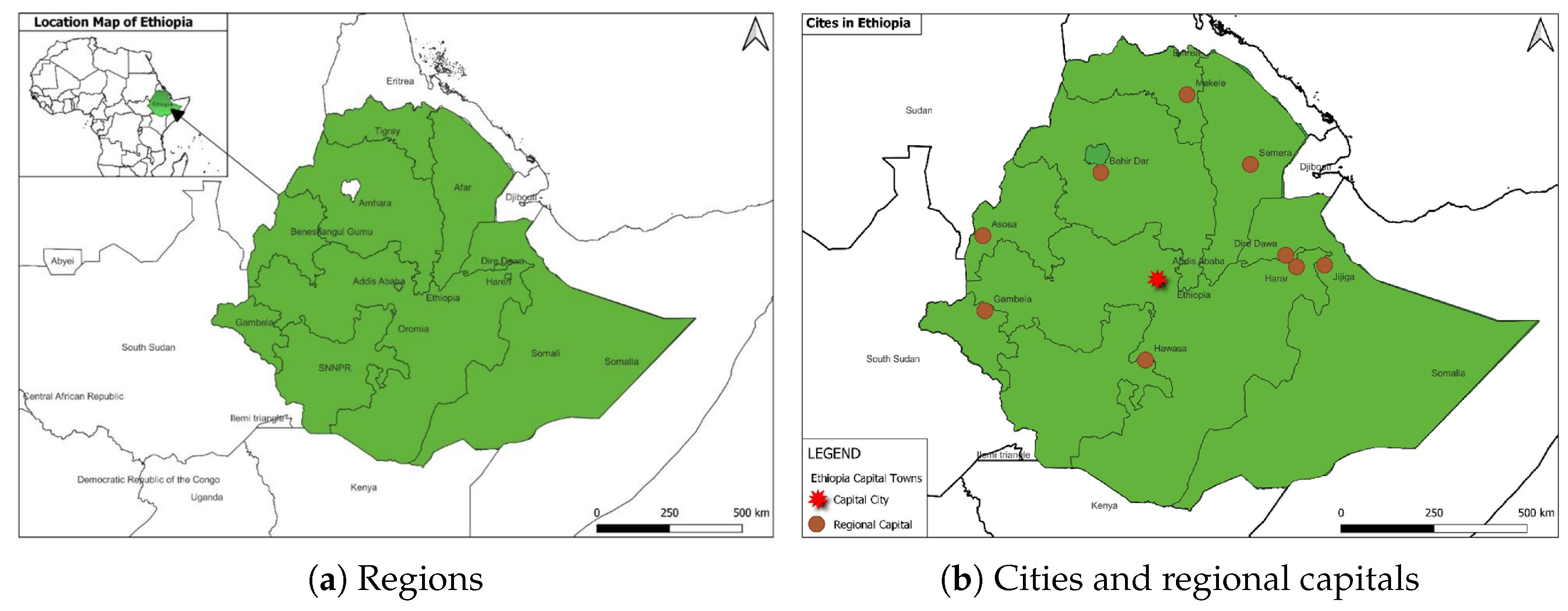
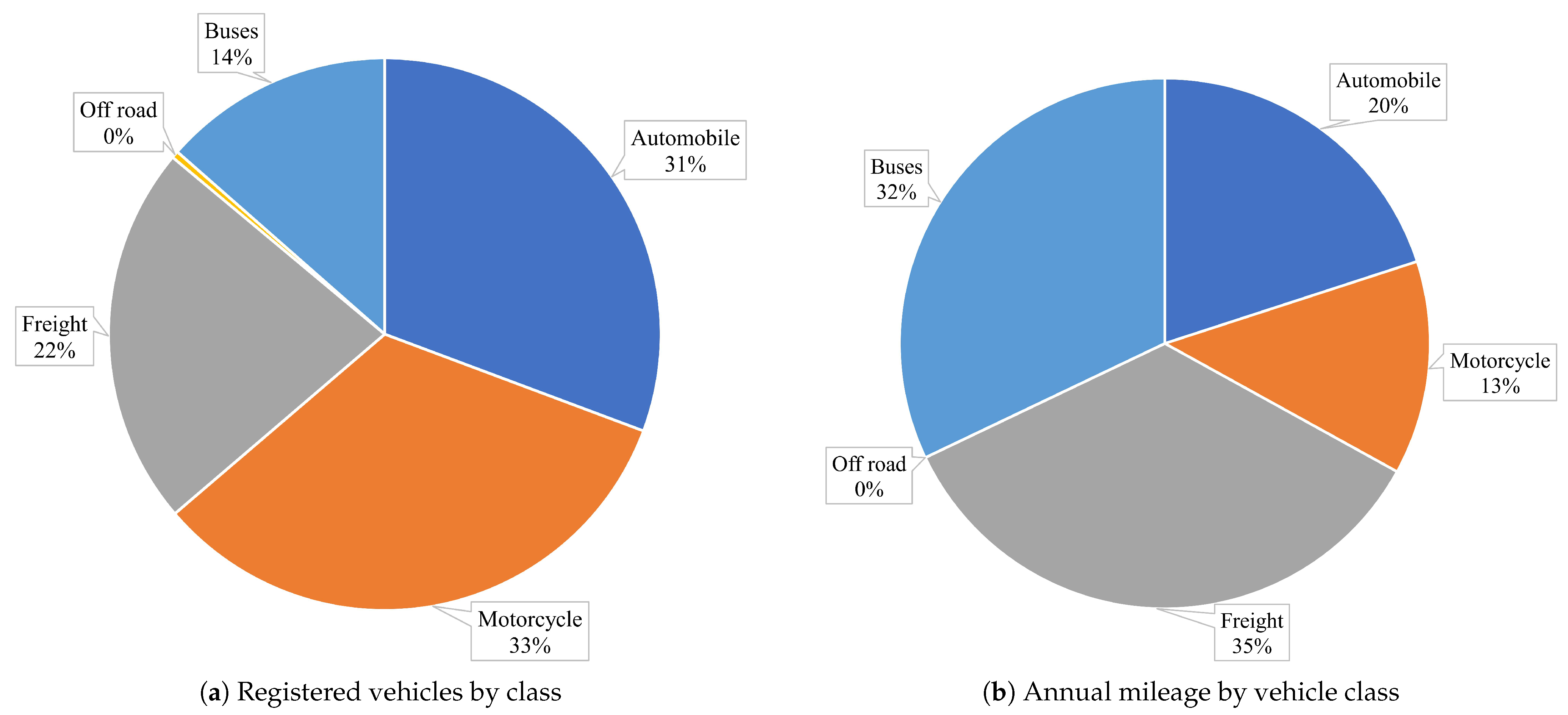
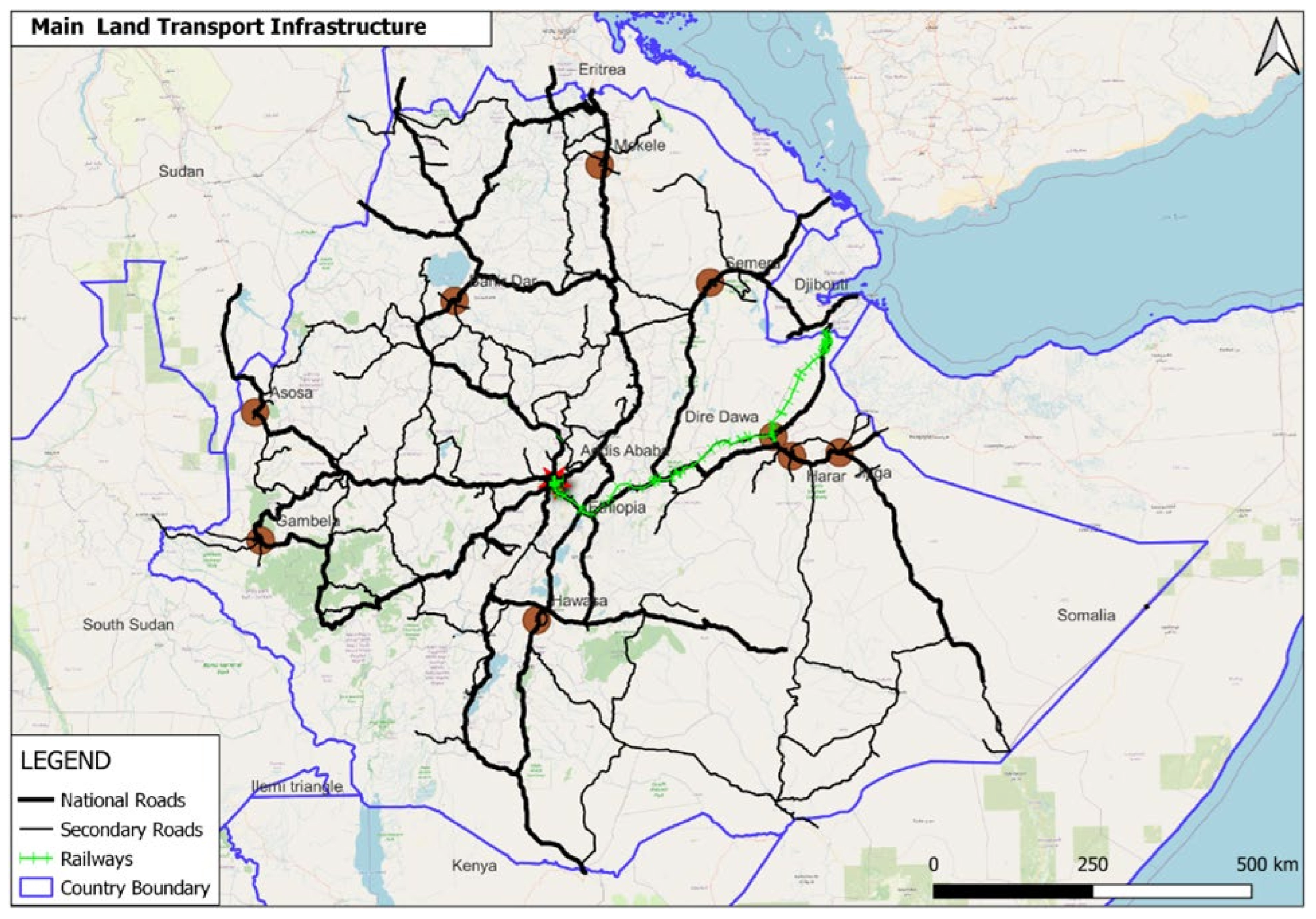

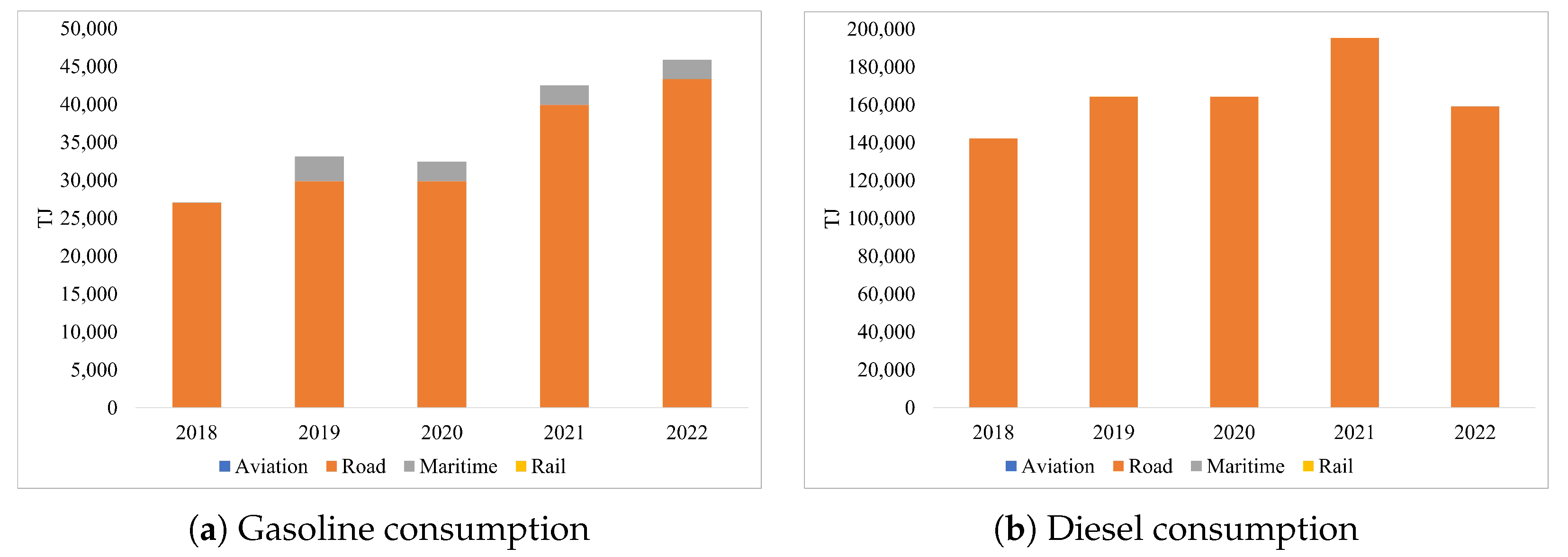
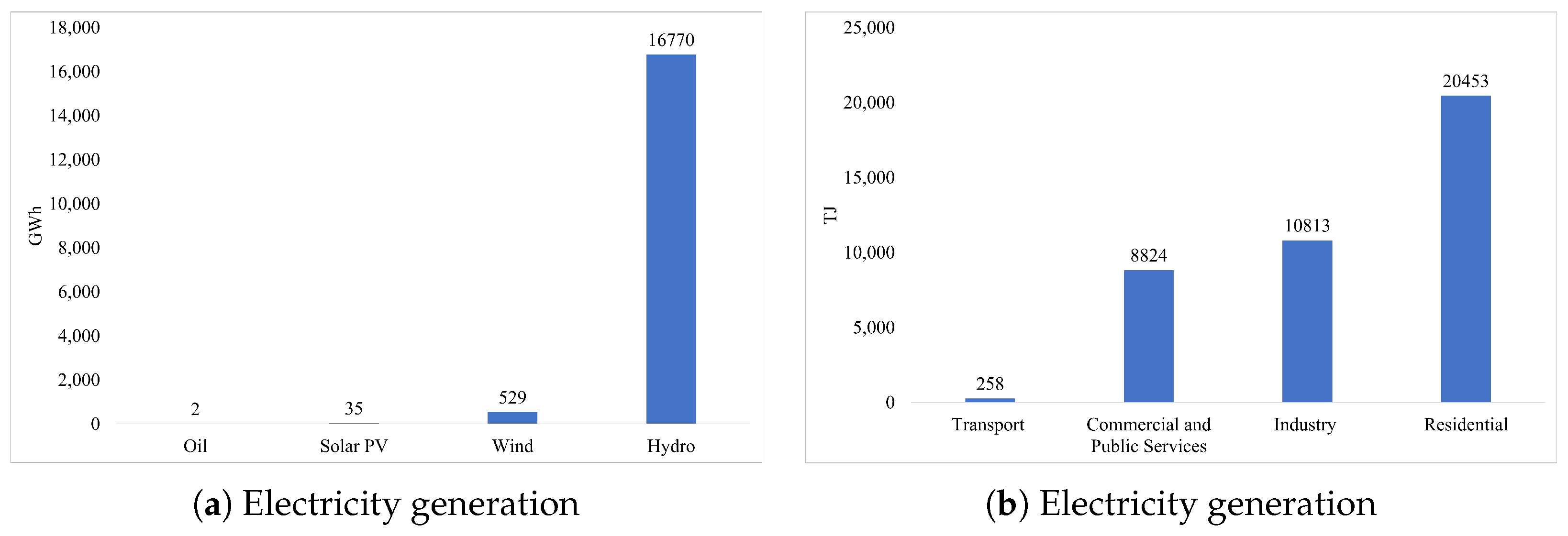
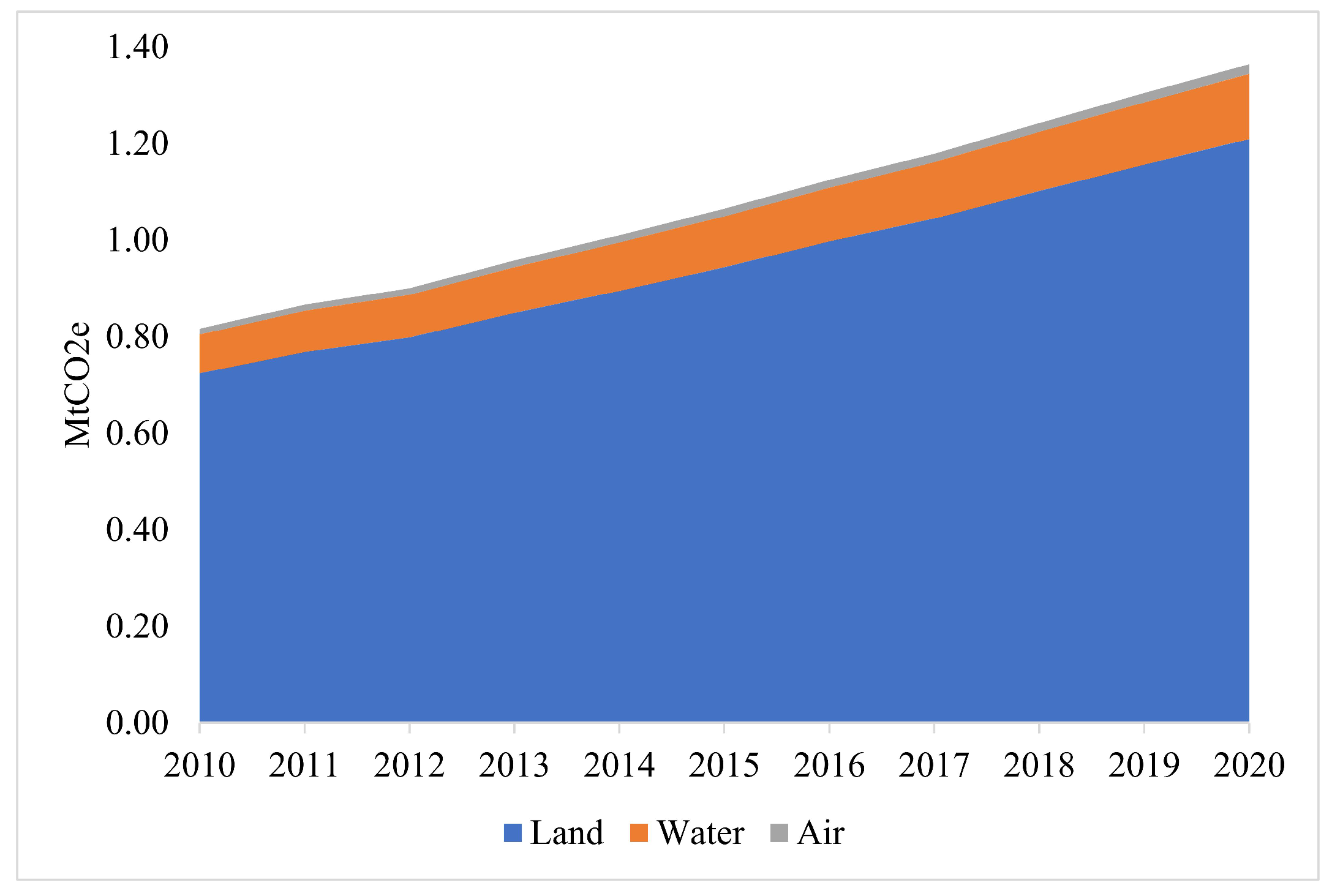


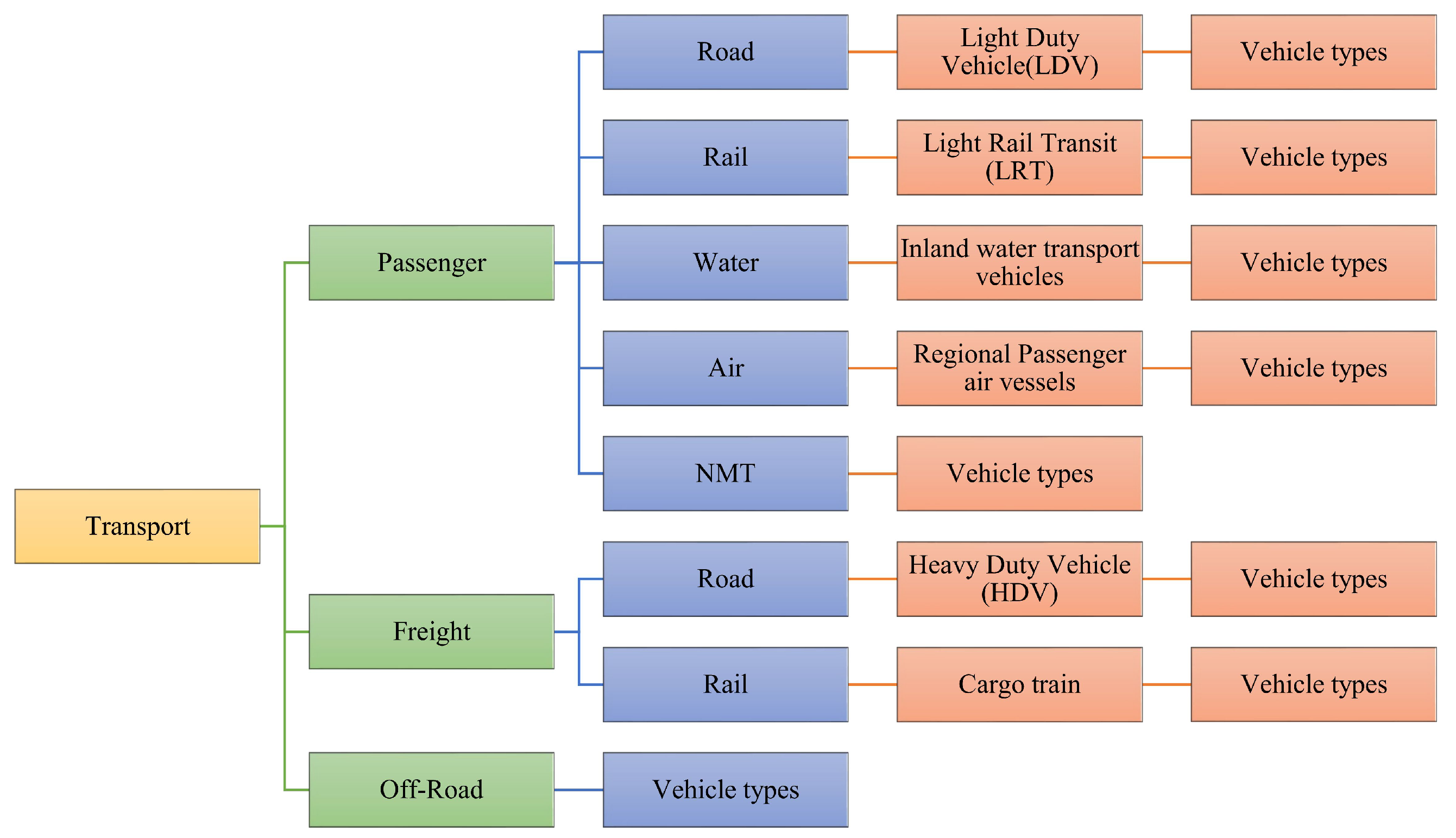
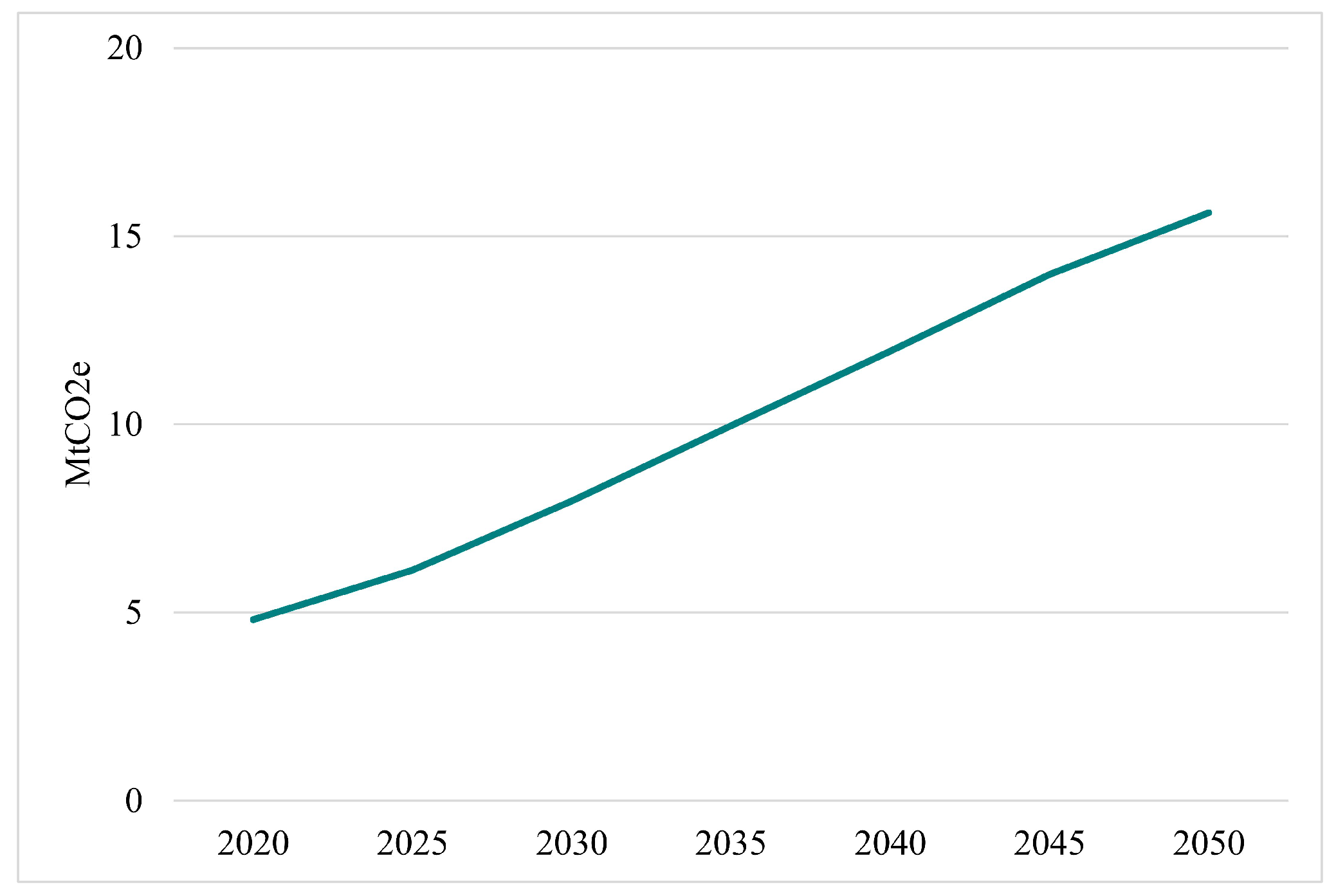
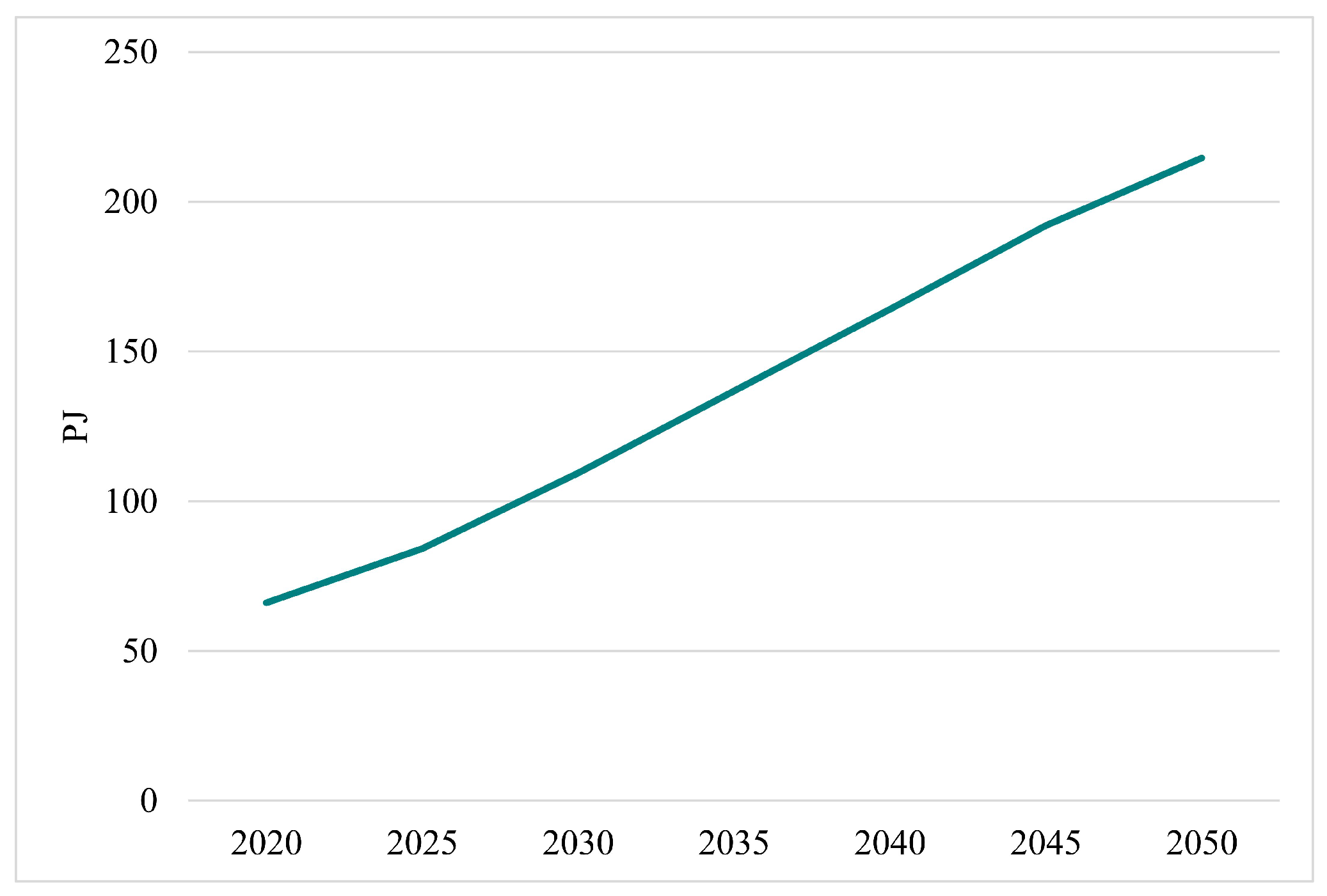
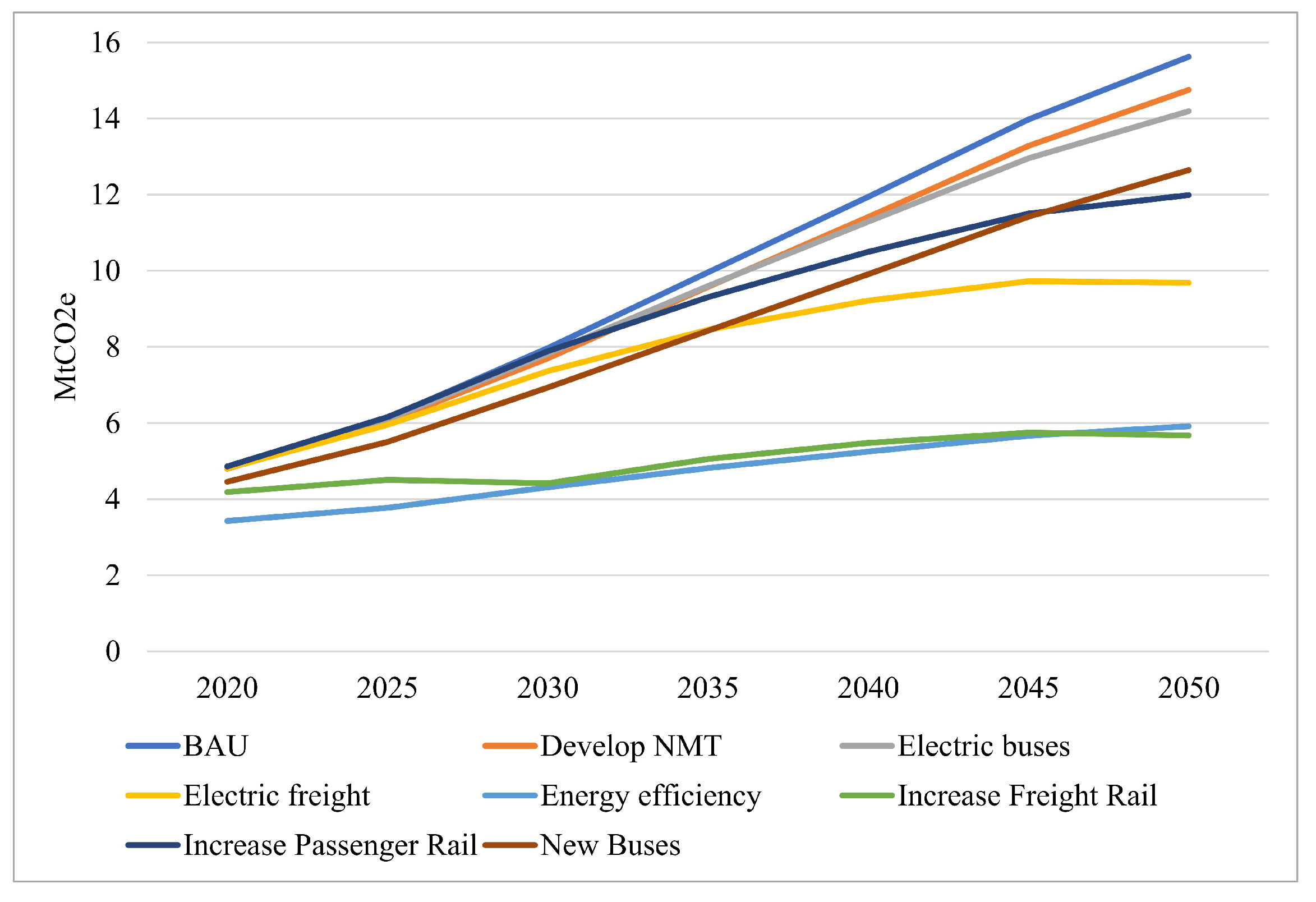

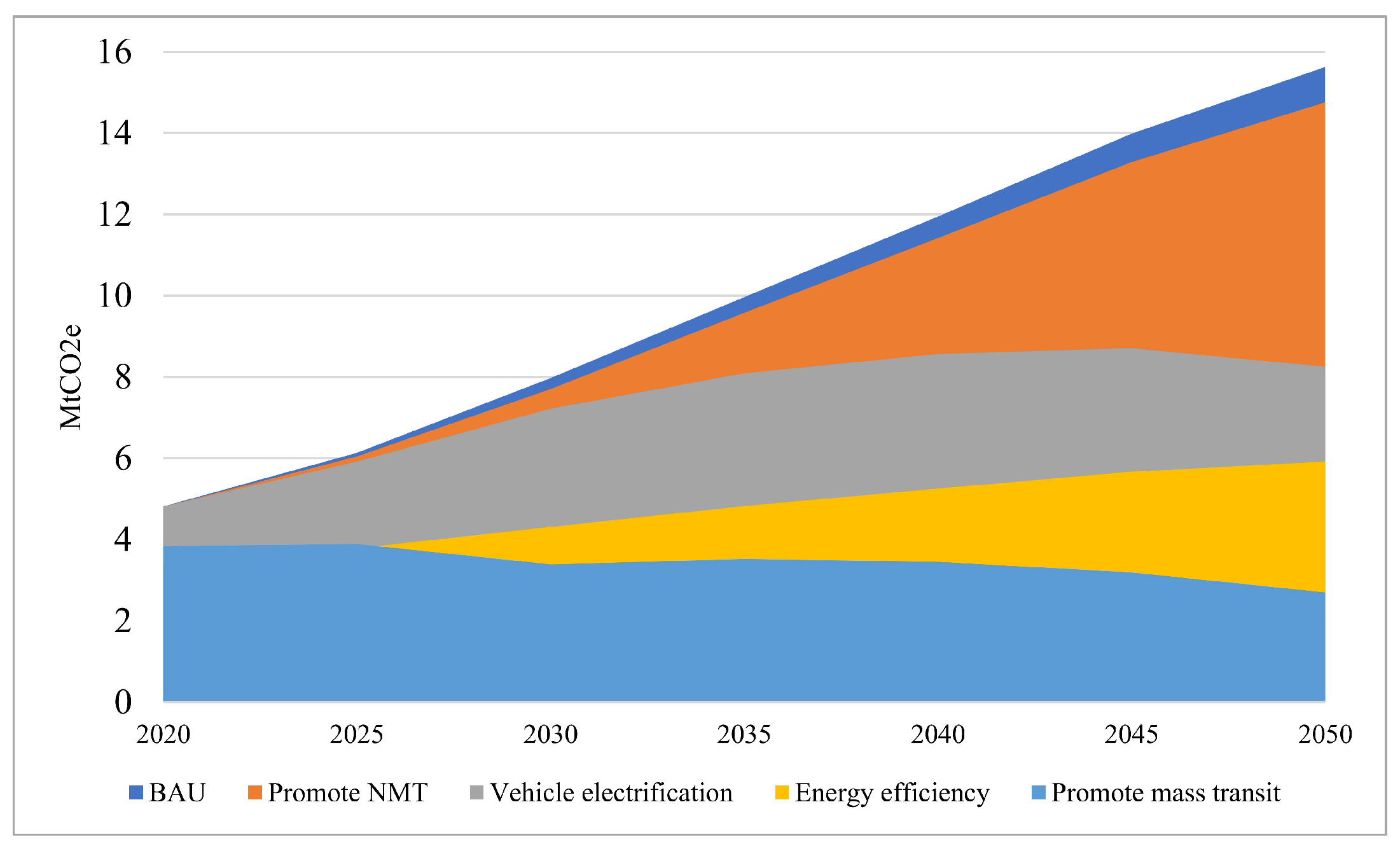
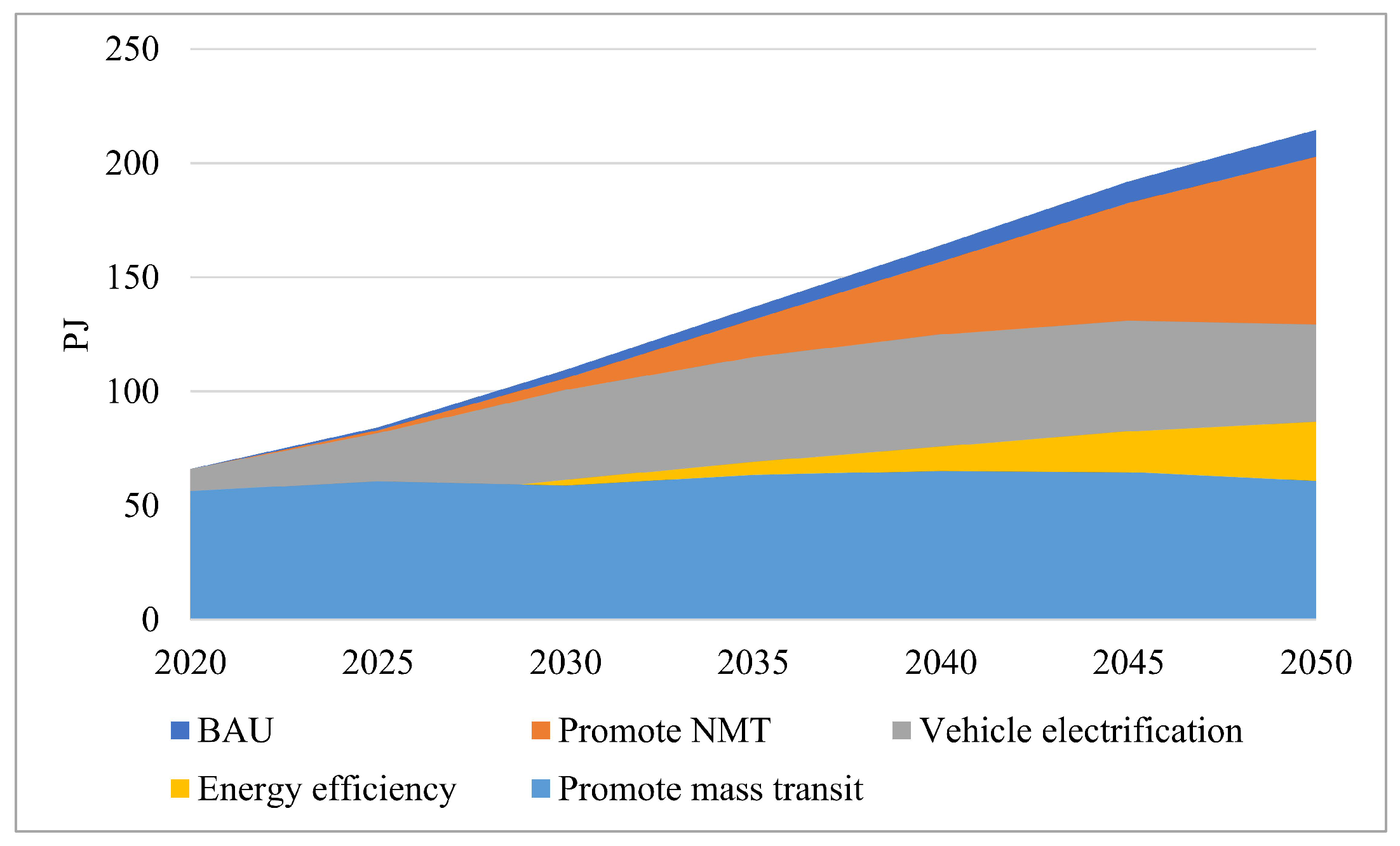
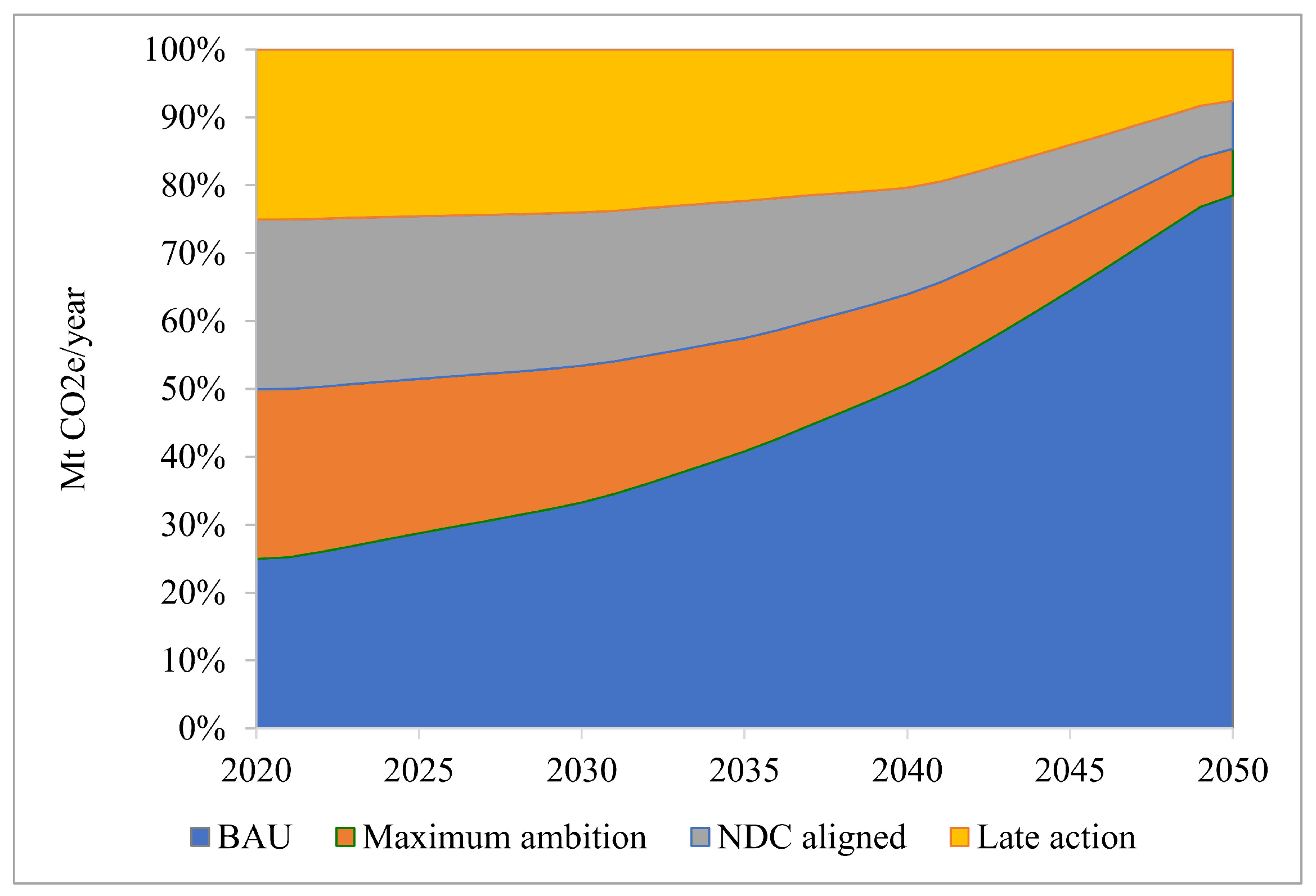
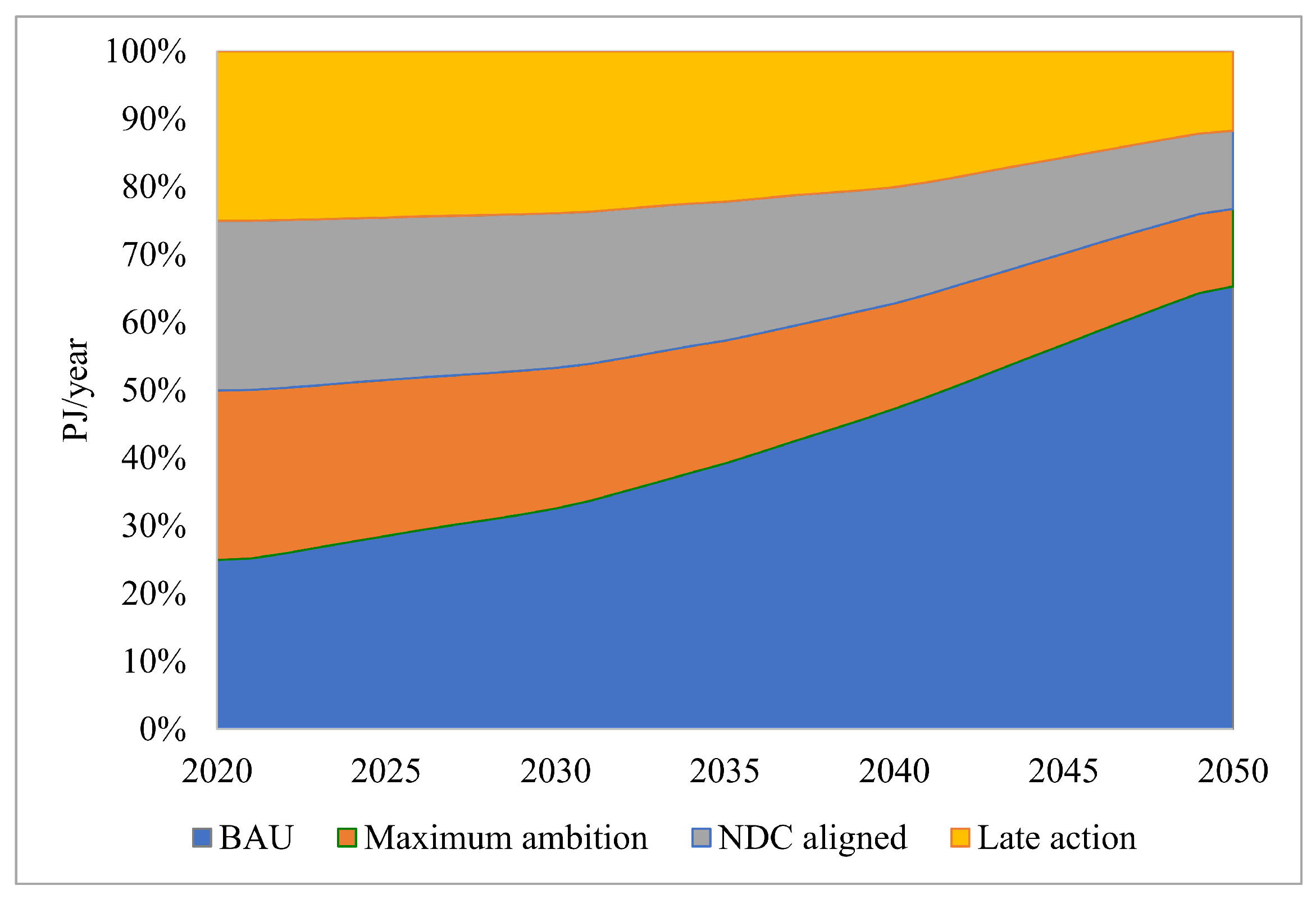
| Category | Subsector | Transport Activity |
|---|---|---|
| Road | Road infrastructure | Road construction, repair, and maintenance |
| Road transport | Urban transportation of people, goods, and services | |
| Rail | Rail transport | Rail line construction, repair, and maintenance |
| Passenger and freight rail movement | ||
| Air | Air transport | Passenger and cargo movement |
| Airstrip construction | ||
| Sea | Maritime transport | Expansion of dry ports, inland water transport services |
| Other | Pipeline transport | Construction and provision of commodity pipelines |
| Data Type | Data | Description | Unit |
|---|---|---|---|
| Transport | Vehicle categories | Main class of vehicles | - |
| Vehicle types | Sub-class of vehicles | - | |
| Vehicle number | Stock of each vehicle type | - | |
| Average Annual VKT | Km travelled per vehicle class annually | Veh-km | |
| Fuel type | Fuel type used to power vehicle types | - | |
| Fuel economy | Avr fuel economy per vehicle type | Km/L | |
| Avr annual fuel demand | Avr annual fuel consumed per vehicle type | L/Veh/yr | |
| Macroeconomic | Population | Size of the population | - |
| Population growth | Rate of population increase | - | |
| VKT growth | Rate of growth of vehicle use | - | |
| GDP growth | Rate of population increase | Km/L | |
| Energy | Energy efficiency | Energy efficiency of fuel types | - |
| Energy demand | Total transport energy demand | - | |
| GHG Emissions | Emission factors | Conversion factor for fuel based pollutants | - |
| Plans and Policies | Climate, transport | Local relevant studies and reports | - |
| Veh Categories | Veh Type | Fuel Type |
|---|---|---|
| Private cars and buses | Ambulance | Gasoline |
| Automobile | Gasoline | |
| Field Vehicle | Diesel | |
| Bus (≤12 Seats) | Gasoline | |
| Two- and three-wheelers | Bajaj | Gasoline |
| Tricycle | Gasoline | |
| Motor Bicycle | Gasoline | |
| Three-Wheel Dry Land | Gasoline | |
| Three-Wheel Public Load | Gasoline | |
| Heavy-Duty Trucks and Buses | Bus (>12 seats) | Diesel |
| Dual-Purpose Vehicle | Diesel | |
| Dry Cargo (≤10 Quintals) | Diesel | |
| Dry Cargo (>10 Quintals) | Diesel | |
| Gotach | Diesel | |
| Liquid Cargo | Diesel | |
| Off-Road | Combiner | Diesel |
| Dozer | Diesel | |
| Grader | Diesel | |
| Forklift | Diesel | |
| Tractor | Diesel | |
| Vehicle with Machinery | Diesel |
| Intervention | 2020 | 2030 | 2040 | 2050 |
|---|---|---|---|---|
| Shift from Petroleum to Hybrid and Electric Vehicles | ||||
| Maximum Ambition Scenario | 0% | 15% | 44.5% | 75% |
| NDC-Aligned Scenario | 0% | 10% | 34.5% | 75% |
| Late Action Scenario | 0% | 7.5% | 15% | 75% |
| Enhance NMT (Cycling, Walking) | 5% | 60% | – | 100% |
| Improve Mass Transport (BRT, Rail, Bus) | 34% | 70% | – | 100% |
| Fuel Quality and Efficiency | 0% | 16% | 18% | – |
| Vehicle Age Limit | 0% | 100% | – | – |
| Improve Transport Mobility (Parking, Reduce congestion) | 0% | 50% | – | – |
| Increase Share of Rail Transport | ||||
| Freight | 7% | 7% | 20% | 50% |
| Passenger | 2% | 10% | – | 50% |
Disclaimer/Publisher’s Note: The statements, opinions and data contained in all publications are solely those of the individual author(s) and contributor(s) and not of MDPI and/or the editor(s). MDPI and/or the editor(s) disclaim responsibility for any injury to people or property resulting from any ideas, methods, instructions or products referred to in the content. |
© 2025 by the authors. Licensee MDPI, Basel, Switzerland. This article is an open access article distributed under the terms and conditions of the Creative Commons Attribution (CC BY) license (https://creativecommons.org/licenses/by/4.0/).
Share and Cite
Nnene, O.A.; Senshaw, D.; Zuidgeest, M.; Mwaura, O.; Yitayih, Y. Developing Low-Carbon Pathways for the Transport Sector in Ethiopia. Climate 2025, 13, 96. https://doi.org/10.3390/cli13050096
Nnene OA, Senshaw D, Zuidgeest M, Mwaura O, Yitayih Y. Developing Low-Carbon Pathways for the Transport Sector in Ethiopia. Climate. 2025; 13(5):96. https://doi.org/10.3390/cli13050096
Chicago/Turabian StyleNnene, Obiora A., Dereje Senshaw, Mark Zuidgeest, Owen Mwaura, and Yizengaw Yitayih. 2025. "Developing Low-Carbon Pathways for the Transport Sector in Ethiopia" Climate 13, no. 5: 96. https://doi.org/10.3390/cli13050096
APA StyleNnene, O. A., Senshaw, D., Zuidgeest, M., Mwaura, O., & Yitayih, Y. (2025). Developing Low-Carbon Pathways for the Transport Sector in Ethiopia. Climate, 13(5), 96. https://doi.org/10.3390/cli13050096






